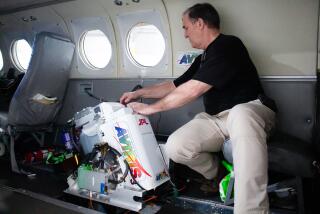Craft Poised to Run Rings Around Saturn
After seven years and 2.2 billion miles, the most complicated and expensive unmanned spaceflight ever attempted is nearing its destination -- the exotic and colorful ringed planet Saturn.
On Wednesday evening, the Cassini spacecraft will navigate a treacherous path through the rings of Saturn, fire its retrorocket and, if all goes well, enter a broad looping orbit around the majestic planet.
Over the next four years, the spacecraft will make at least 74 orbits, including 44 close encounters with Saturnâs largest moon, Titan. It will also fly past another 16 of the planetâs 31 known major moons. With luck, the craft could continue to collect data for 15 years.
On Christmas Eve, the craft will launch a small probe named Huygens to the frigid surface of Titan -- the only moon in the solar system with a dense atmosphere -- to search for the organic chemicals that are the building blocks of life.
âOur objective is very simple -- to allow us to rewrite the story of the âLord of the Rings,â â said Charles Elachi, director of the Jet Propulsion Laboratory in Pasadena and principal scientist for the radar probe aboard Cassini.
âSome people have been working 15 years for this,â added Robert Mitchell, Cassini program manager at JPL. âOur emotions are starting to build: anticipation, excitement, relief and a bit of anxiety.â
The arrival of the craft at Saturn represents, in many ways, the end of an era. Cassiniâs cost, massive size and payload of 18 scientific instruments sets it âapart from recent interplanetary missions launched under the âfaster, better, cheaperâ slogan,â said David Doody, a flight operations manager at JPL.
That mantra, developed by former NASA Administrator Daniel S. Goldin, led to a new generation of spacecraft that weigh less, cost less and take less time to develop than any in NASAâs history.
With the new emphasis at NASA on a return to the moon and a manned mission to Mars, it seems unlikely that there will be another mission to Saturn in the next few decades, and almost certain that none will be so complex. Scientists are hoping to unravel as many of the planetâs secrets as possible with this one.
The craft also holds a special place in the hearts of researchers at JPL because the $3.3-billion program, funded by NASA, the European Space Agency and the Italian Space Agency, was the only major project sustaining the lab during the gap between the loss of Mars Observer in 1993 and the beginning of work on the Mars rovers. In the peak year of 1995, at least 1,500 scientists and engineers at JPL worked on it full or part time.
Cassini faces a difficult obstacle in braking into orbit around Saturn. âThis is not a slam-dunk,â Mitchell said.
Streaking toward Saturn at 49,000 mph, Cassini will come up from underneath the planet on the sunlit side of the rings and thread its way between the F and G rings -- two of the fainter ones near the outer edge of the planetâs ring system -- an 18,600-mile gap that is undoubtedly littered with undetectable bits of rocks and ice.
The Voyager 2 and Pioneer spacecraft both passed safely through the gap, but experts noted that it would take only one wayward piece of rock or ice hitting the craft to permanently disable it.
Twenty-five minutes after passing through the gap, at 7:36 p.m. PDT, Cassini will fire its engine for 96 minutes to reduce its speed by 1,400 mph, just enough to allow it to be captured by Saturnâs gravity.
That is the only maneuver in the entire mission that has to be done precisely, Mitchell said. âOtherwise, it becomes a Saturn flyby.â
To that end, the craft carries a redundant rocket motor in case the first one doesnât fire. The computer that operates Cassini will fire the rocket âno matter what happens,â Mitchell said. âThe spacecraft will not let the burn go by, even in the presence of faults.â
While the rocket is firing, the craft will make its closest approach to Saturn, swooping in to a distance of just more than 12,400 miles from the fringes of the atmosphere. The craft will then speed once more through the F-G gap, returning to the underside of the plane of the rings.
This will be the closest the craft will come to the rings. Normally, a spacecraft at this point would be checking its engineering data and returning the information to Earth. But after sending a quick burst of data to confirm the burn, Cassini will focus its attention on the rings.
âWe want to look at the rings while we can,â Elachi said. âWeâll never be that close again.â
Only after about an hour of observation will the craft turn its antenna back toward Earth and begin sending back the large amounts of data collected during its entry into orbit.
A miniature âsolar systemâ unto itself, Saturn was known to ancient scholars, although its unusual nature did not emerge until Galileo first viewed it through a telescope in 1609. He discovered that the planetâs size varied with time, sometimes appearing much larger than normal.
That mystery was solved nearly half a century later by Dutch astronomer Christiaan Huygens, who was the first to see the planetâs rings clearly. He concluded that the planet had appeared large to Galileo when the rings were at a right angle to his rudimentary telescope, and much smaller when he viewed them edge-on. Huygens also discovered Titan in 1655.
Huygensâ observations were confirmed by the Italian-French astronomer Giovanni Domenico Cassini. In 1675, he noticed that Saturnâs rings were separated into two major sections: The gap is known as the Cassini Division. He also discovered the moons Iapetus, Rhea, Tethys and Dione.
Much of the information about Saturn was gleaned through three previous flybys of the planet: Pioneer 11 in September 1979, Voyager 1 in November 1980 and Voyager 2 in August 1981.
Saturn itself is nearly the size of Jupiter, but it is made mainly of gas and is the only known planet that is less dense than water. If it could be placed in a gigantic bathtub, it would float.
The planet has a massive magnetic field and radiates more energy than it receives from the sun. Its stormy atmosphere has distinct, colored bands that persist for long periods of time and winds that have been clocked at 1,120 mph.
Some unknown process on Saturn also generates low-frequency radio waves, while strong radio outbursts are thought to be caused by âsuper boltsâ of lightning. Cassiniâs instruments will monitor these processes, mapping the planetâs global temperature structure and determining the composition of atmospheric gases, hazes and clouds.
Saturn âoffers so much scientific insight because itâs so rich in phenomena,â said imaging team leader Carolyn C. Porco of the Space Science Institute in Boulder, Colo.
For many scientists and the public, the âcenter stageâ of Cassiniâs mission will be its study of Saturnâs rings, Doody said.
Composed of billions of pieces of ice and rock ranging in size from smoke particles to boulders the size of a house, the rings are broad -- about 260,000 miles wide overall -- but extraordinarily thin: only tens to hundreds of yards thick.
âWe want to find out what they are made of, how old they are, what their dynamic is,â Elachi said. âWe want to understand their formation because that will shed light on how dust disks [elsewhere in the universe] lead to the formation of planets.â
Others want to study the gaps in the rings -- how they are formed and how they are maintained over long periods. âFor me, that is one of the biggest objectives,â Porco said.
Some gaps, such as the Cassini Division, are thought to be caused by the moons in a phenomenon researchers call resonance. The small moon Mimas, for example, orbits outside the rings with a period of 22.6 hours. Objects at the distance of the Cassini Division would have a period of about 11.3 hours.
Any rocks and boulders originally in what is now the Cassini Division would have been tugged repeatedly by Mimasâ gravity at the same point in every orbit, nudging them out of the gap.
Other gaps are caused more directly by moons. The particles in a smaller gap called the Encke Division, for example, are swept clear by the tiny moon Pan.
The team also wants to study spoke-like features in Saturnâs B ring -- one of its largest, near the center of the ring system. Theoretically, such spokes should not exist because the particles at different distances from the planet have different orbital speeds, so the spokes should be quickly torn apart.
The craft will also study Saturnâs known moons -- 13 of the 31 have been discovered since Cassini was launched -- and look for others. âThe chances of finding additional moons are very good,â Mitchell said.
One of the more intriguing moons is Mimas, only 240 miles in diameter. Mimas bears a massive crater -- 80 miles wide -- named Herschel, from an impact that nearly shattered the moon. Cassini will fly by looking for cracks from the impact and other features that may reveal its history.
Another alluring target is Enceladus, which Porco and others think may be similar to Jupiterâs moon Europa. Tidal stresses on the 310-mile-diameter moon may liquefy water believed to be beneath its surface. Cassini will swoop within 300 miles of the surface to see if this water erupts in geysers to produce fresh snow.
But the most inviting moon of all is Titan. At 3,200 miles across, it is larger than Earthâs moon and is enveloped in a dense atmosphere composed mainly of nitrogen.
Titanâs atmosphere is rich in organic molecules -- much as Earthâs may have been before life developed here -- and its surface is thought to have large lakes of liquid hydrocarbons. The sunâs action on the chemicals produces an orange smog that has prevented previous missions from imaging the moonâs surface.
On Dec. 24, Cassini will launch the Huygens probe, built by the European Space Agency, toward Titan. Three weeks later, the 703-pound capsule and its six instruments will parachute to the surface, taking continuous measurements and photographs throughout the 2- to 2 1/2-hour descent.
If scientists are lucky, the probe may even survive for a few minutes on the surface, transmitting data back for as long as the batteries can operate in the moonâs minus-289 degree Fahrenheit temperature.
Researchers do not expect the probe to discover life on Titan because it is too cold, but they hope it will give insights into how life might have gotten started elsewhere.
âThe most important thing our generation can do is understand the origin of life in our solar system,â Elachi said.
More to Read
Sign up for Essential California
The most important California stories and recommendations in your inbox every morning.
You may occasionally receive promotional content from the Los Angeles Times.










